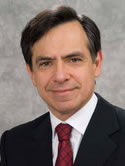Sacral resection for recurrent rectal cancer: Analysis of morbidity and treatment results Journal Article
| Authors: | Melton, G. B.; Paty, P. B.; Boland, P. J.; Healey, J. H.; Savatta, S. G.; Casas Ganem, J. E.; Guillem, J. G.; Weiser, M. R.; Cohen, A. M.; Minsky, B. D.; Wong, W. D.; Temple, L. K. |
| Article Title: | Sacral resection for recurrent rectal cancer: Analysis of morbidity and treatment results |
| Abstract: | PURPOSE: Composite sacropelvic resection for locally advanced recurrent rectal cancer is a high-risk procedure that benefits select patients. We reviewed our recent institutional experience to evaluate case selection, morbidity, and outcomes. METHODS: Between 1987 and 2004, 29 patients underwent composite resection for recurrent locoregional rectal cancer (17 females; median age, 60 years). Clinicopathologic indicators were evaluated as indicators of survival by log-rank test and Cox proportional hazards model. RESULTS: Of 29 total patients, 27 (93 percent) received radiotherapy with their previous surgery (n = 10; 34 percent) or before sacrectomy (n = 17; 59 percent), and 12 (41 percent) received intraoperative therapy. Sacral resections were performed at S2/S3 (55 percent) or S4/S5 (45 percent) using anterior (41 percent) or combined anterior-posterior approach (59 percent), with adherence to (62 percent) or cortical invasion in (38 percent) the sacrum. A majority of those who had undergone previous abdominoperineal resection had total exenteration (9/13), whereas most patients who had undergone a previous sphincter-preserving procedure had abdominoperineal resection (12/16) and none had exenteration. Pedicle flaps (omental, 11; abdominal rectus, 7) often were used. A median of five (range, 1-33) units of blood was given intraoperatively. Transfusions were associated with previous abdominoperineal resection (P < 0.03), correlating strongly with postoperative morbidity (P < 0.02). There were 33 complications in 17 (59 percent) patients, most commonly perineal wound breakdown (9 (31 percent)) and pelvic abscess (5 (17 percent)). Median hospital stay was 18 (range, 7-56) days, significantly longer in patients with previous abdominoperineal resection (P < 0.02) or postoperative morbidity (P < 0.03). The only postoperative death was from pelvic sepsis. Resection was complete (R0) in 18 patients (62 percent), with microscopically positive margins (R1) in 10 (34 percent) and grossly positive margins (R2) in 1 (3 percent). Two-year and five-year recurrence rates were 47 and 85 percent, respectively; disease-specific survival was 63 and 20 percent, respectively. Less transfusion (P = 0.03), R0 resection (P = 0.005), lack of anterior organ involvement (P = 0.02), and absence of cortical bone invasion (P < 0.001) were associated with better survival on univariate analysis; original colorectal cancer stage was not. CONCLUSIONS: Sacrectomy for rectal cancer is a high-risk procedure that can achieve clear resection margins with low mortality in select patients. This procedure has a low cure rate but may provide local disease control with acceptable morbidity. © The American Society of Colon and Rectal Surgeons. |
| Keywords: | adult; clinical article; treatment outcome; aged; aged, 80 and over; middle aged; survival analysis; cancer surgery; surgical technique; retrospective studies; review; cancer recurrence; pelvis; adenocarcinoma; computer assisted tomography; neoplasm recurrence, local; proportional hazards models; morbidity; postoperative complication; postoperative complications; colonoscopy; wound infection; rectal neoplasms; rectum cancer; sacrum; rectum surgery; rectal cancer; evisceration; infectious complication; rectum anterior resection; rectum abdominoperineal resection; pelvis abscess; bone resection; sacrectomy; sacral resection |
| Journal Title: | Diseases of the Colon and Rectum |
| Volume: | 49 |
| Issue: | 8 |
| ISSN: | 0012-3706 |
| Publisher: | Lippincott Williams & Wilkins |
| Date Published: | 2006-08-01 |
| Start Page: | 1099 |
| End Page: | 1107 |
| Language: | English |
| DOI: | 10.1007/s10350-006-0563-9 |
| PUBMED: | 16779712 |
| PROVIDER: | scopus |
| DOI/URL: | |
| Notes: | --- - "Cited By (since 1996): 30" - "Export Date: 4 June 2012" - "CODEN: DICRA" - "Source: Scopus" |
Altmetric
Citation Impact
BMJ Impact Analytics
MSK Authors
Related MSK Work










